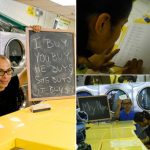Meet a NYFA Artist: Ken Schles
NYFA speaks with 1989 Photography Fellow Ken Schles.
NYFA: Hi Ken, please tell us what you are working on and what’s coming up for you.
KS: I’ve been working on a new photo book these last few years and I’m working hard to get that book out into the world. It’s my fourth monograph—called Oculus. It was published by the Dutch foundation Noorderlicht. I’ve worked with them for well over 12 years on various projects. I didn’t think at first to have them publish this piece. Their primary focus is solidly on documentary photography, and I didn’t think at first this project was quite the right fit. Although my piece does work as documentary in a very real sense, it doesn’t fit into traditional notions of what I think traditional documentary photography looks like or is necessarily a subject that traditional documentary photography might explore.
In broad terms, my book considers the nature of images in various guises: images in memory and the use of the image as a construct to define our personhood or to define our world. Oculus also looks at the image as it functions on the printed page as metaphor. But these investigations are not idle or abstract discussions. The root of this exploration, what gave birth to and sustained these inquiries was a deeply personal (and troubling) set of circumstances.
Oculus started with a question—a question about images and the way they function. It started with finding myself in a particular circumstance and confronting, what was for me, a particularly difficult time. Oculus is also a direct outgrowth of ideas I explored in my last book, A New History of Photography. In that book I discussed at length an observation that my pictures, usually made in a ‘documentary style,’ often reflected images I already had in memory. Oculus investigates the phenomena of images in memory as well, but looks at the subject from a very different perspective.
I can put an exact date to this project, March of 2009. It started while I was researching a talk for ICP in New York City. In that talk, I quote an article that started with the opening lines of Nabokov’s Speak, Memory; “The cradle rocks above an abyss, and common sense tells us that our existence is but a brief crack of light between two eternities of darkness. Although the two are identical twins, man, as a rule, views the prenatal abyss with more calm than the one he is headed for (at some forty-five hundred heartbeats an hour)” The author connected the metaphor of light to consciousness and memory (New York Review of Books, Michael Greenberg, Just Remember This, December 4, 2008). I had been thinking about memory (and forgetting) more concretely around this time, as I was in the throes of confronting a troubling situation involving my two elderly parents. They had both been diagnosed with Alzheimer’s and were insisting on taking care of themselves, in their own home, with as little help or outside intervention as possible. At first this seemed empowering: a bid for continued self-sufficiency. But they were isolated and argumentative. Any intervention was seen as an attack on their autonomy. My father became increasingly dangerous to himself and to those around him, as well as violent and abusive—never mind the house falling into disrepair and my mother’s diabetes, stroke and broken nose. It was also about this time that my wife was diagnosed with a serious viral infection, which she had been carrying from before we met, over 25 years ago. She began a debilitating course of treatment that would last nearly a year, with a forty percent chance for a positive outcome. There was a period of time where I didn’t know if my wife had transmitted her illness to my children or myself. Perhaps it was because of these difficulties that I became so interested in the nexus between image and memory. And then, in 2008, when the economy collapsed, my means of making a living took a severe blow. I gave up my studio and moved my practice into my home. I began to question all manner of images: What does it mean to have “family,” what does it mean to “love,” or more simply put, what does it means to define or describe oneself through an image? During this uncertain time I had begun to almost obsessively photographing my children as they slept—in fact I ended my last book, (A New History of Photography: The World Outside and The Pictures In Our Heads, White Press, Köln, 2008) with an image of my son sleeping. I extended this fascination/obsession to include other sleeping children we knew through families in the neighborhood and I began to think more on what Nabokov’s “crack of light” might represent. We all use metaphors of light and we have been using metaphors of light since, well, since the “dawn of civilization.”I notice we use metaphors of light to represent activities of the mind—for knowledge and consciousness and awareness. We say, “I had a brilliant idea,” or “that was illuminating.” We might use these terms for historical awareness as well, like in “the dark ages, ”which was a time that was not so “illuminated,” before the enlightenment. History describes our cultural memory, our collective “crack of light between two eternities of darkness.“ But the trigger for me to really contemplate the nature of the image and these metaphors of light was because of personal travails and a stark realization of our fragile being. I think it is because of my circumstances the project has an urgency and an intimacy that is quite palpable. This book might not, at first glance, appear to have the stereotypical look of documentary photography, but it is documentary in a very real sense: I image the local surface of things to describe a state of the world as I see it. It is an exploration of my predicament and mindset and seeks in the world what lies within my own heart and mind.I cannot say that this, in itself, is so unusual—it’s something we all do, and quite naturally: We see and seek out in the world a reflection of our own thoughts and desires and project those images back into the world once again. And through it all, the image provides a transfer point, a context for ideas that we can each explore and understand, and hopefully, connect to. I think that Oculus works with these photographic principles to render an experience that is as compelling as it is unique.
NYFA: How and when did you begin taking photographs?
KS: It wasn’t until the second year of college. I was going to Cooper Union for the Advancement of Science and Art. In the second foundation year I had to take a photography course. I hadn’t been thinking of photography at all—I was studying painting and design. I also had taken sculpture with Hans Haacke. It was at Cooper that I became involved in a reading group that was organized by Martha Rosler. I think another of my influential teachers there was Ruben Kadish, a sculptor who was a contemporary of Philip Guston and Jackson Pollack. He would always kid me because he thought art was something created over the course of time and he saw the camera solely as a reductionist tool. He’d see me with a camera and ask, “What is that machine? It just slices off slivers of time!” But through this tool we can explore our relationship to the world and to things in the world. And through the course of making a body of work, and through the medium of a book, we can explore these relationships across time to make larger statements and explore very nuanced ideas.
NYFA: How did receiving your NYFA Fellowship affect your career?
KS: I received my NYFA Fellowship twenty-two years ago. It was just after my first book came out. Although Invisible City (1988) was widely acclaimed, this didn’t bring with it much in the way of compensation, other than praise. I wasn’t quite sure where to go with my work or what to do to get moving ahead with the business of making my art. I was flat broke and feeling frustrated, a little trapped. The NYFA Fellowship started several things going for me. First, it led to a public exhibition of my work (at the 92nd Street Y). Something that was very difficult for me to accomplish at the time. Second, it gave me a little bit of means to invest in my work. I already had a camera and a darkroom. I thought I could buy film and shoot more, buy paper and chemicals and print more, or buy more camera equipment. I did do a little of that, but I decided primarily to do something I hadn’t the means to contemplate otherwise, something I thought might help me in the long term that wasn’t as consumable as film or paper—so I bought my first computer. I knew that technology was going to transform my medium. This was before practical digital cameras and working color printers. I got a Mac SE. It was B&W and the images were bitmapped, but I was able to grow with the technology and use it for all the things we take computers for granted for today. Only back then it was a revelation. It professionalized my work in many ways. But more than any of the material benefits of the Fellowship (which I sorely needed) was the sheer knowledge that I was accepted as a peer. Isn’t that what being a Fellow means—that you are part of a group of like-minded artists, accepted in your field? It gave me the confidence, the fool-hardy confidence to continue in the face of adversity to continue with something I believed in. It took me twelve years to come out with my next book, The Geometry of Innocence, but the Fellowship got that project going. They say the sophomore project is the hardest. Luckily, I received the Fellowship early on in that process which helped sustain confidence during that long and difficult project. John Szarkowski once told me that he felt that my work was important, but that it might face some difficulty finding a place on gallery walls. I cannot over emphasize the importance that getting a NYFA Fellowship had in my early development and the confidence it gave me to pursue a direction that was somewhat non-traditional.
NYFA: You talk about influences and obsessions in your book A New History of Photography and how they manifest in things we create, what are some influences and obsessions that can be seen in your work?
KS: There have been many influences and maybe too many obsessions. My previous book—a finalist for the book award at Arles and a book of the year on Photo-eye and 5b4 (two online resources for photographic books)—talks about the nature of influence in detail. And I think you can plainly see those influences in the work I do. More broadly speaking we are creatures that mimic; truly, it’s what we do best. What we love, what we see, even what we hate: these are things we emulate. It’s in our nature to be influenced by and to carry-on practice. We all influence each other’s “ways of seeing.” All of that is unavoidable—and we want this to happen, otherwise we’d have no history, and no present either, no culture and no technology, our future would be unconnected to any past. But we must be wary of what we replicate and be cognizant of what we do and say and ask why we might want to contribute to this spectacle of culture. I look at the making of art to be engaged in a kind of discussion. We can say it’s a discussion about influence embodied in an image and projected through an image. Art is a means to discuss the human predicament and its possibilities. And influence is a measure of the power of particular images to define how a large number of people might see and might possibly know the world. I see throughout my work a discussion about the influence of the image. In my first book, Invisible City, I explored the image of “the city” and started that book with an excerpt from Lewis Mumford’s The Culture of Cities where he says, “In the city, time becomes visible: buildings and monuments and public ways, more open than the written record, more subject to the gaze of many men than the scattered artifacts of the countryside, leave an imprint upon the minds even of the ignorant or the indifferent. Through the material fact of preservation, time challenges time, time clashes with time: habits and values carry over beyond the living group, streaking with different strata of time the character of any single generation. Layer upon layer, past times preserve themselves in the city until life itself is finally threatened with suffocation.” The material form of a place has a distinct influence and imparts a particular character to the lives of the people who live there. My second book, The Geometry of Innocence (2001), which I mentioned briefly above, was inspired by my brother, who died of terminal cancer at the age of 37. He had the deathbed revelation that he had unquestioningly taken on the dreams and aspirations of the prevailing culture. He realized he never questioned his (admittedly assumed) role in society, never found out who he thought he might be; who he could have been. His life was defined by the images he found himself immersed in. I start that book with a parable from Kafka: “They were offered the choice between becoming kings or the couriers of kings. The way children would, they all wanted to be couriers. Therefore there are only couriers who hurry about the world, shouting to each other—since there are no kings—messages that have become meaningless. They would like to put an end to this miserable life of theirs but they dare not because of their oaths of service.” I end that book with a quote from Guy Debord’s Society of the Spectacle: “What brings together men liberated from their local and national boundaries is also what pulls them apart. What requires a more profound rationality is also what nourishes the irrationality of hierarchic exploitation and repression. What creates the abstract power of society creates its concrete unfreedom.”
In A New History of Photography: The World Outside and the Pictures In Our Heads (2008), I explore the presence of images in my memory as an almost organic and Darwinian reflection and projection of a kind of history of photography. Susan Sontag says in Regarding The Pain of Others that “The familiarity of certain photographs builds our sense of the present and immediate past. Photographs lay down routes of reference…Photographs that everyone recognizes are now a constituent part of what society chooses to think about. It calls these ideas "memories,” and that is, over the long run, a fiction. Strictly speaking there is no such thing as collective memory. But there is collective instruction.“
With Oculus, I continue an exploration of images in memory that I started in A New History of Photography, but look at images from a very different perspective. Our images are projections that are representative of our awareness of the world. With Oculus, I explore the various uses of the image: images in mind, poetic metaphor, and photographic images. Our images are metaphors that can illuminate, and be, in Nabokov’s phraseology, "a crack of light between our two eternities of darkness.” No matter the difficulties we face this will always be true: our images connect us to the possibility that we might see the world in a new and more profound way.
I hope people will take an interest in this project. Perhaps I can end with this mention I just received on Oculus:
“…quite simply it’s one of the best new photobooks I have seen in years: a towering accomplishment filled with aesthetic beauty and emotional depth. I can assure you this book will be a classic. …it gave me chills from beginning to end.” — Harper Levine (Harper’s Books) Jury Member for Le Prix du Livre Paris Photo 2011 .
Ken Schles will be signing Oculus at the International Center of Photography on Thursday, December 15, 6:00pm–7:30pm.
ICP
1133 Avenue of the Americas
New York, NY
For more information, visit the ICP website
Purchase a copy of Oculus,here.
Visit Ken Schles’ blog here
Visit his official Facebook pagehere.
And click here for Google+
For more information on Ken Schles, visit his website.





